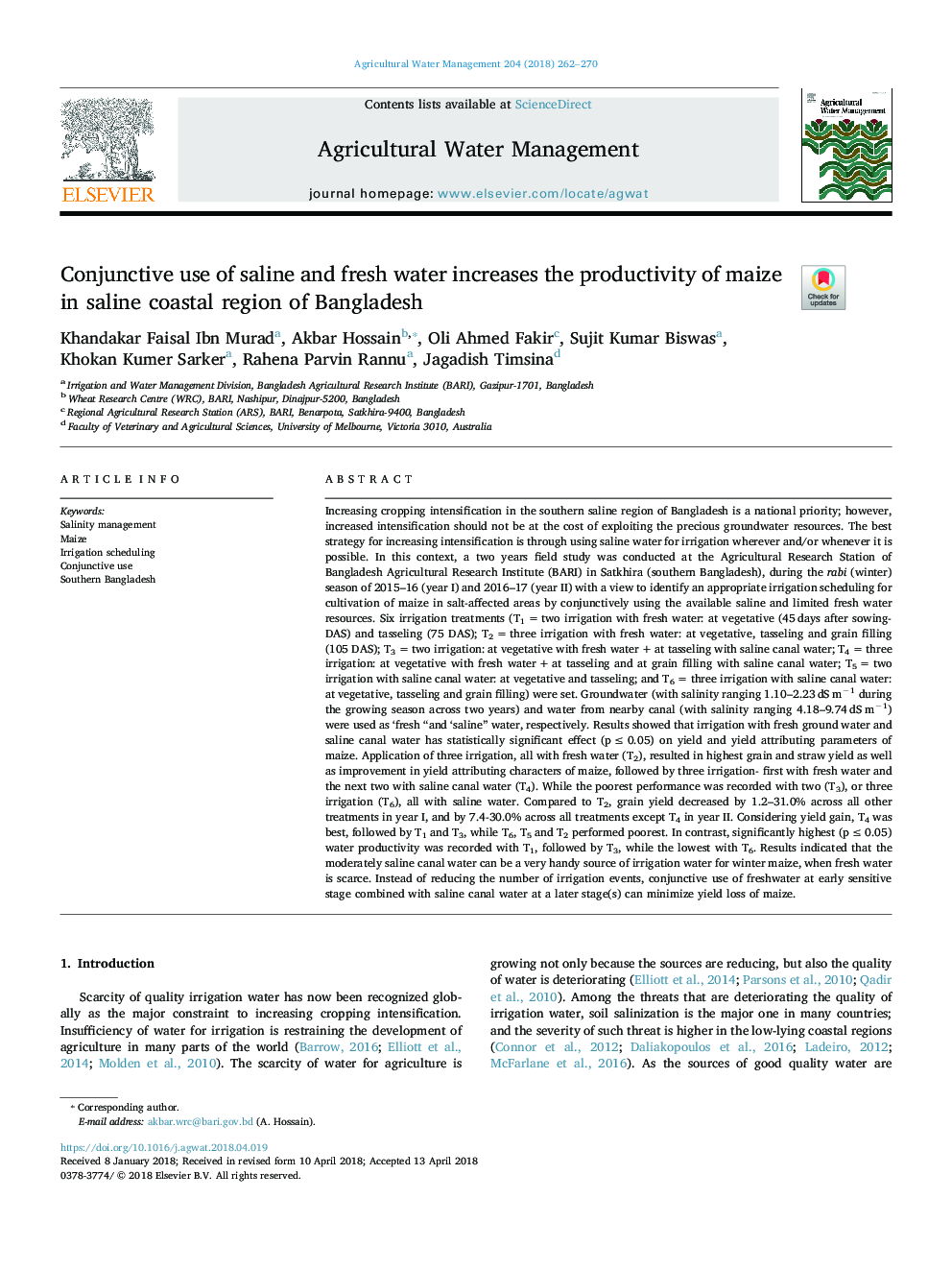| کد مقاله | کد نشریه | سال انتشار | مقاله انگلیسی | نسخه تمام متن |
|---|---|---|---|---|
| 8872909 | 1622876 | 2018 | 9 صفحه PDF | دانلود رایگان |
عنوان انگلیسی مقاله ISI
Conjunctive use of saline and fresh water increases the productivity of maize in saline coastal region of Bangladesh
ترجمه فارسی عنوان
استفاده مضر از نمک و آب تازه باعث افزایش بهره وری ذرت در منطقه ساحلی سالن بنگلادش می شود
دانلود مقاله + سفارش ترجمه
دانلود مقاله ISI انگلیسی
رایگان برای ایرانیان
کلمات کلیدی
مدیریت شوری، ذرت، برنامه ریزی آبیاری، استفاده مضر، جنوب بنگلادش،
موضوعات مرتبط
علوم زیستی و بیوفناوری
علوم کشاورزی و بیولوژیک
علوم زراعت و اصلاح نباتات
چکیده انگلیسی
Increasing cropping intensification in the southern saline region of Bangladesh is a national priority; however, increased intensification should not be at the cost of exploiting the precious groundwater resources. The best strategy for increasing intensification is through using saline water for irrigation wherever and/or whenever it is possible. In this context, a two years field study was conducted at the Agricultural Research Station of Bangladesh Agricultural Research Institute (BARI) in Satkhira (southern Bangladesh), during the rabi (winter) season of 2015-16 (year I) and 2016-17 (year II) with a view to identify an appropriate irrigation scheduling for cultivation of maize in salt-affected areas by conjunctively using the available saline and limited fresh water resources. Six irrigation treatments (T1â¯=â¯two irrigation with fresh water: at vegetative (45â¯days after sowing-DAS) and tasseling (75 DAS); T2â¯=â¯three irrigation with fresh water: at vegetative, tasseling and grain filling (105 DAS); T3â¯=â¯two irrigation: at vegetative with fresh waterâ¯+â¯at tasseling with saline canal water; T4â¯=â¯three irrigation: at vegetative with fresh waterâ¯+â¯at tasseling and at grain filling with saline canal water; T5â¯=â¯two irrigation with saline canal water: at vegetative and tasseling; and T6â¯=â¯three irrigation with saline canal water: at vegetative, tasseling and grain filling) were set. Groundwater (with salinity ranging 1.10-2.23â¯dSâ¯mâ1 during the growing season across two years) and water from nearby canal (with salinity ranging 4.18-9.74â¯dSâ¯mâ1) were used as 'fresh “and 'saline” water, respectively. Results showed that irrigation with fresh ground water and saline canal water has statistically significant effect (pâ¯â¤â¯0.05) on yield and yield attributing parameters of maize. Application of three irrigation, all with fresh water (T2), resulted in highest grain and straw yield as well as improvement in yield attributing characters of maize, followed by three irrigation- first with fresh water and the next two with saline canal water (T4). While the poorest performance was recorded with two (T3), or three irrigation (T6), all with saline water. Compared to T2, grain yield decreased by 1.2-31.0% across all other treatments in year I, and by 7.4-30.0% across all treatments except T4 in year II. Considering yield gain, T4 was best, followed by T1 and T3, while T6, T5 and T2 performed poorest. In contrast, significantly highest (pâ¯â¤â¯0.05) water productivity was recorded with T1, followed by T3, while the lowest with T6. Results indicated that the moderately saline canal water can be a very handy source of irrigation water for winter maize, when fresh water is scarce. Instead of reducing the number of irrigation events, conjunctive use of freshwater at early sensitive stage combined with saline canal water at a later stage(s) can minimize yield loss of maize.
ناشر
Database: Elsevier - ScienceDirect (ساینس دایرکت)
Journal: Agricultural Water Management - Volume 204, 31 May 2018, Pages 262-270
Journal: Agricultural Water Management - Volume 204, 31 May 2018, Pages 262-270
نویسندگان
Khandakar Faisal Ibn Murad, Akbar Hossain, Oli Ahmed Fakir, Sujit Kumar Biswas, Khokan Kumer Sarker, Rahena Parvin Rannu, Jagadish Timsina,
